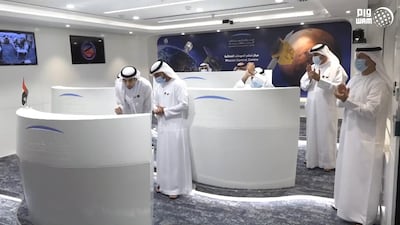
An image of the Martian polar ice cap taken by the UAE’s Hope probe and processed by graphic designer Jason Major. Photo: Emirates Mars Mission / Jason Major

The first image of Mars captured by the Hope probe on February 10, 2021. Photo: UAE Space Agency / Hope probe

It was launched on July 20, 2020 and went into orbit around the Red Planet on February 9, 2021. Photo: Dubai Media Office / Twitter

A composite image of Mars' tiny moon Deimos captured by the UAE's Hope probe: Photo: Hope probe

Hessa Al Matroushi is the Science Deputy Project Manager in the Emirates Mars Mission. Museum of Future, Dubai. Chris Whiteoak / The National

Mohsen Al Awadhi (L), director of space missions department at the UAE space agency and Zakareya Al Shamsi, deputy project director for operations of the Mars mission. Chris Whiteoak / The National

The Hope probe was launched from Japan's Tanegashima island. The mission is led by the Mohammed bin Rashid Space Centre in Dubai. AFP

Mission director Omran Sharaf announces that the Hope probe has successfully entered orbit around Mars. Photo: Wam

An image of the Martian polar ice cap taken by the UAE’s Hope probe and processed by graphic designer Jason Major. Photo: Emirates Mars Mission / Jason Major

The first image of Mars captured by the Hope probe on February 10, 2021. Photo: UAE Space Agency / Hope probe

It was launched on July 20, 2020 and went into orbit around the Red Planet on February 9, 2021. Photo: Dubai Media Office / Twitter

A composite image of Mars' tiny moon Deimos captured by the UAE's Hope probe: Photo: Hope probe

Hessa Al Matroushi is the Science Deputy Project Manager in the Emirates Mars Mission. Museum of Future, Dubai. Chris Whiteoak / The National

Mohsen Al Awadhi (L), director of space missions department at the UAE space agency and Zakareya Al Shamsi, deputy project director for operations of the Mars mission. Chris Whiteoak / The National

The Hope probe was launched from Japan's Tanegashima island. The mission is led by the Mohammed bin Rashid Space Centre in Dubai. AFP

Mission director Omran Sharaf announces that the Hope probe has successfully entered orbit around Mars. Photo: Wam

An image of the Martian polar ice cap taken by the UAE’s Hope probe and processed by graphic designer Jason Major. Photo: Emirates Mars Mission / Jason Major
UAE’s Hope probe moves to new orbit to study Mars’ tiny moon Deimos
A new science mission begins as the UAE celebrates two years since Hope reached Mars

Sarwat Nasir
09 February, 2023
- Listen In English
- Listen In Arabic